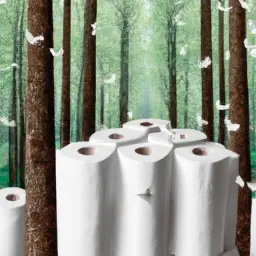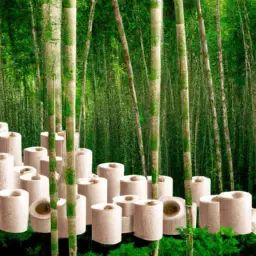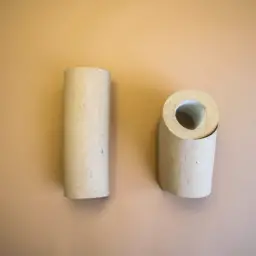Hey there!
So, I’ve been doing some research on toilet paper choices, and I wanted to share what I found.
In this article, we’re going to debunk some common myths about bamboo toilet paper. You know, the kind that’s more sustainable and eco-friendly?
I’ll address concerns about its softness and safety for septic systems, and we’ll also dive into the cost-effectiveness of making the switch.
So, let’s get started and separate fact from fiction!
The Environmental Impact of Traditional Toilet Paper Manufacturing

One of the main environmental impacts of traditional toilet paper manufacturing is the significant amount of trees that are cut down to produce it. This deforestation impact is a major contributor to the problem of toilet paper pollution.
Every year, millions of trees are felled to meet the global demand for toilet paper, leading to the destruction of natural habitats and loss of biodiversity. Not only does this result in the loss of valuable ecosystems, but it also contributes to climate change. Trees play a crucial role in absorbing carbon dioxide and releasing oxygen, so when they’re cut down, the balance is disrupted.
Additionally, the process of manufacturing toilet paper involves the use of chemicals and bleaching agents that can contaminate water sources and harm aquatic life. The pollution caused by toilet paper manufacturing has far-reaching consequences for our environment and our health.
It’s important for consumers to be aware of these impacts and consider alternative options, such as recycled or bamboo toilet paper, which have a lower environmental footprint. By making conscious choices, we can help reduce the deforestation impact and protect our planet for future generations.
Why Bamboo Toilet Paper Is a Sustainable Alternative

I believe that bamboo toilet paper is a sustainable alternative because it is renewable, biodegradable, and has a lower environmental impact compared to traditional toilet paper. Bamboo is known for its fast growth, making it a highly renewable resource. It can be harvested within just 3-5 years, while trees used for traditional toilet paper can take decades to reach maturity. This means that bamboo can be sustainably sourced without depleting forests.
In addition to its renewable nature, bamboo toilet paper is also biodegradable. It breaks down easily in water and decomposes quickly, reducing the strain on landfills. This is in contrast to traditional toilet paper, which can take years to decompose and contribute to waste accumulation.
Furthermore, the sourcing process and production of bamboo toilet paper is often eco-friendly. Bamboo plants require minimal water and do not require pesticides or fertilizers to grow, reducing the use of harmful chemicals. Additionally, the manufacturing process of bamboo toilet paper typically involves less energy and produces fewer carbon emissions compared to traditional toilet paper production.
To illustrate the sustainability of bamboo toilet paper, here is a comparison table:
| Bamboo Toilet Paper | Traditional Toilet Paper | |
|---|---|---|
| Renewability | Renewable resource | Trees take decades to reach maturity |
| Biodegradability | Easily breaks down in water and decomposes quickly | Takes years to decompose |
| Environmental Impact | Minimal water usage, no pesticides or fertilizers | Higher energy usage and carbon emissions |
Dispelling the Myths: Is Bamboo Toilet Paper as Soft as Traditional Brands

But is bamboo toilet paper as soft as traditional brands? This is a common misconception about bamboo toilet paper when compared to recycled toilet paper. Many people assume that because bamboo is a natural material, it may not be as soft and comfortable as traditional brands. However, this isn’t necessarily true.
Bamboo toilet paper is often praised for its softness and comfort. It’s made from bamboo fibers that are processed and refined to create a smooth and gentle texture. In fact, some users even claim that bamboo toilet paper is softer than traditional brands made from recycled materials.
The misconception that bamboo toilet paper isn’t as soft may stem from the belief that recycled toilet paper is the only environmentally friendly option. While recycled toilet paper is indeed a sustainable choice, it’s important to note that bamboo toilet paper is also a highly sustainable alternative. Bamboo is a fast-growing plant that requires minimal resources to grow, making it an eco-friendly option for toilet paper production.
Addressing Concerns: Is Bamboo Toilet Paper Safe for Septic Systems

Many people wonder if bamboo toilet paper is safe for septic systems. The good news is that bamboo toilet paper is indeed safe and compatible with septic systems. The unique properties of bamboo make it an ideal choice for those concerned about the breakdown of toilet paper in their septic tanks.
Bamboo toilet paper is made from the fibers of the bamboo plant, which are naturally strong and durable. These fibers are also highly biodegradable, meaning they break down easily in water. This is important for septic systems, as they rely on the breakdown of waste and toilet paper to function properly.
Unlike traditional toilet paper, which can take a long time to break down, bamboo toilet paper breaks down quickly and efficiently. This helps to prevent clogs and blockages in septic systems, ensuring that they continue to operate smoothly.
In addition to its septic system compatibility, bamboo toilet paper is also an environmentally friendly choice. Bamboo is a fast-growing and renewable resource, making it a sustainable alternative to traditional toilet paper made from trees.
Exploring the Cost-Effectiveness of Switching to Bamboo Toilet Paper

The cost-effectiveness of switching to bamboo toilet paper can be a practical and sustainable choice for individuals seeking an affordable and environmentally friendly option. When considering the economic viability of bamboo toilet paper, it’s important to take into account both the upfront cost and the long-term savings.
While bamboo toilet paper may have a slightly higher initial price compared to traditional toilet paper, it often comes in larger rolls which can lead to fewer frequent purchases. Additionally, bamboo is a fast-growing plant, making it a more renewable resource compared to trees. This means that the production costs of bamboo toilet paper can be lower in the long run, potentially resulting in cost savings for consumers.
Consumer perception also plays a crucial role in the cost-effectiveness of switching to bamboo toilet paper. As more people become aware of the environmental impact of traditional toilet paper, there’s a growing demand for sustainable alternatives. This increased demand for bamboo toilet paper has led to more competition in the market, which can help drive prices down. Furthermore, many consumers are willing to pay a slightly higher price for a product that aligns with their values and contributes to a healthier planet.
Conclusion
In conclusion, choosing bamboo toilet paper as a sustainable alternative to traditional brands offers a soft and safe option for your septic system. The long-term benefits of making the switch outweigh any initial concerns, despite a slight difference in cost.
By making this small change in your toilet paper choices, you can contribute to a greener and more eco-friendly future.

